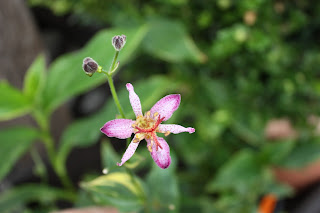 |
| The 'Samuri' Toad Lily has variegated leaves |
The name “toad lily” may sound like an oxymoron. But this is one toad you don’t have to kiss to get a princely flower.
Its exotic blooms, often a combination of purple and cream, resemble miniature orchids. They also provide wonderful color in the shade garden this time of year when few other perennials are blossoming.
These Asian natives have been in cultivation for quite a while. They were discovered in Japan in 1784 and have been grown in this country since the 1890s. It was only after the Chicago Botanic Garden published a 10-year evaluation of the plant in 2001, however, that toad lilies started becoming more widely available.
Toad lilies, or tricyrtis, require at least part shade and a soil that is consistently moist and fertile. They keep on blooming for a long time, often until a hard frost, and spread by underground rhizomes. Its arching stems will form a "colony” over time.
If you're a worry wart, they are very reliable. Toad lilies are slow to wake up in the spring like many other late bloomers so be patient. And because their flowers are so intricate, you need to put them near a bench or a path where you can admire them up close and personal.
Exactly how toad lilies got their common name is unclear. The blooms are spotted, not unlike a toad. The plants like moisture, unlike some other lilies. Search the Internet and many articles say that early hunters used to smear it on their hands to help them catch toads. Some sites even link the name to a fictitious tribe in the Philippines during the days of dictator Ferdinand Marcos and his shoe-loving wife Imelda (!?)
Wherever its common name came from, be sure to jump on this plant for some fall color. I promise it won't give you warts.
(Photo by Lynn Dipple)
By Karen Geisler

No comments:
Post a Comment